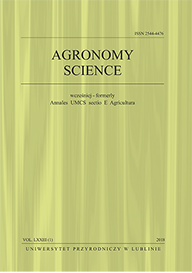Migration of harmful substances from food packaging
Elżbieta Jolanta Bielińska
Instytut Gleboznawstwa i Kształtowania Środowiska, Akademia Rolnicza w Lublinie ul. Leszczyńskiego 7, 20-069 Lublin, PolandAbstract
A substantial amount of chemical substances considered harmful to both man and the environment are part of the raw material from which packaging is made. The process of the migration of food packaging components to food depends on temperature, contact time, the contact surface between packaging and the food product and the product chemical composition. Plastics are widely used for the manufacture of packaging, due to their favourable properties and low
production costs. Trace amounts of monomers from which a given polymer is produced together with auxiliary and refining substances added to plastics can permeate food products. The migration of low-molecular substances is also caused by the processes of depolymerisation, degradation and material destruction under the influence of such factors as: temperature, mechanical stresses and the influence of other chemicals. Heavy metals or their compounds are the most frequent inorganic compounds in packaging materials that pose a potential danger both to people and environment. Heavy metals in packaging materials can originate from raw materials used for production, or they can be introduced during processing. Also, auxiliary and refining substances or recycled materials used in the production of packaging materials such as recycled paper or aluminium, cullet or plastic re-granulates can be the source of heavy metals. Studies on the migration of harmful substance from packaging to food products are significant both from the point of view of health protection and the protection of the natural environment.
Keywords:
food packaging, harmful substances, migrationReferences
Biłyk A., Głomba M. 2000. Dioksyny w środowisku jako uboczny efekt rozwoju cywilizacyjnego. Chem. Inż. Ekol. 7, 8/9, 823–834.
Czerniawski B. 1998. Opakowania żywności. (red. B. Czerniawski i J. Michniewicz). Wyd. Agro Food Technology, Czeladz.
Fołtynowicz Z. 2000. Zastosowanie norm serii ISO 14000 w zakresie opakowań i gospodarki odpadami opakowaniowymi. Opakowanie 6, 14–20.
Huzar E., Trzeszczynski J. 2000. Badanie migracji styrenu i etylobenzenu z opakowań polimerowych do żywności. Chem. Inż. Ekol. 7, 12, 1319–1325.
Juśkiewicz M., Panfil-Kuncewicz H. 1999. Materiały opakowaniowe stosowane w przemyśle spożywczym. Wyd. ART, Olsztyn.
Kluska M., Kroszczyński W. 2000. Zawartość niektórych policyklicznych węglowodorów aromatycznych w pobliżu dróg o dużym natężeniu ruchu. Chem. In¿. Ekol. 7, 6, 563–573.
Makuch B., Wolska L. 2000. Nowoczesne metody analityczne w badaniach migracji specyficznej oraz zawartości substancji toksycznych w opakowaniach. Opakowanie 6, 34–45.
Nowicki P., Kłos M. 1980. Certain problems of toxicity assessment of plastic materials used for blood preservation and preparation. Polish J. Pharmacol. 32, 77–86.
Schnabel W. 1981. Polymer degradation. Principles and practical application, Carl Huser Verlag, München–Wien.
Urbaniak W., Wasiak W., Sobczyńska D., Różalska S. 2000. Substancje niebezpieczne w opakowaniach i odpadach opakowaniowych. Przegląd Komunalny, Dodatek, 11, 134–138.
Wolska L., Rawa-Adkonis M., Namiesnik J. 2001. Opakowania do leków – zagrożenia wynikające z interakcji pomiędzy opakowaniem a lekiem. Chem. In¿. Ekol. 8, 5, 447–462.
Instytut Gleboznawstwa i Kształtowania Środowiska, Akademia Rolnicza w Lublinie ul. Leszczyńskiego 7, 20-069 Lublin, Poland
License
Articles are made available under the conditions CC BY 4.0 (until 2020 under the conditions CC BY-NC-ND 4.0).
Submission of the paper implies that it has not been published previously, that it is not under consideration for publication elsewhere.
The author signs a statement of the originality of the work, the contribution of individuals, and source of funding.
Self-Archiving Policy
Agronomy Science has adopted a self-archiving policy called blue by the Sherpa Romeo database. From 2021 authors can self-archive article postprints and editorial versions (under the CC BY 4.0 licence). Articles from earlier years (available under the CC BY-NC-ND 4.0 licence) can only be self-archived as editorial versions.




